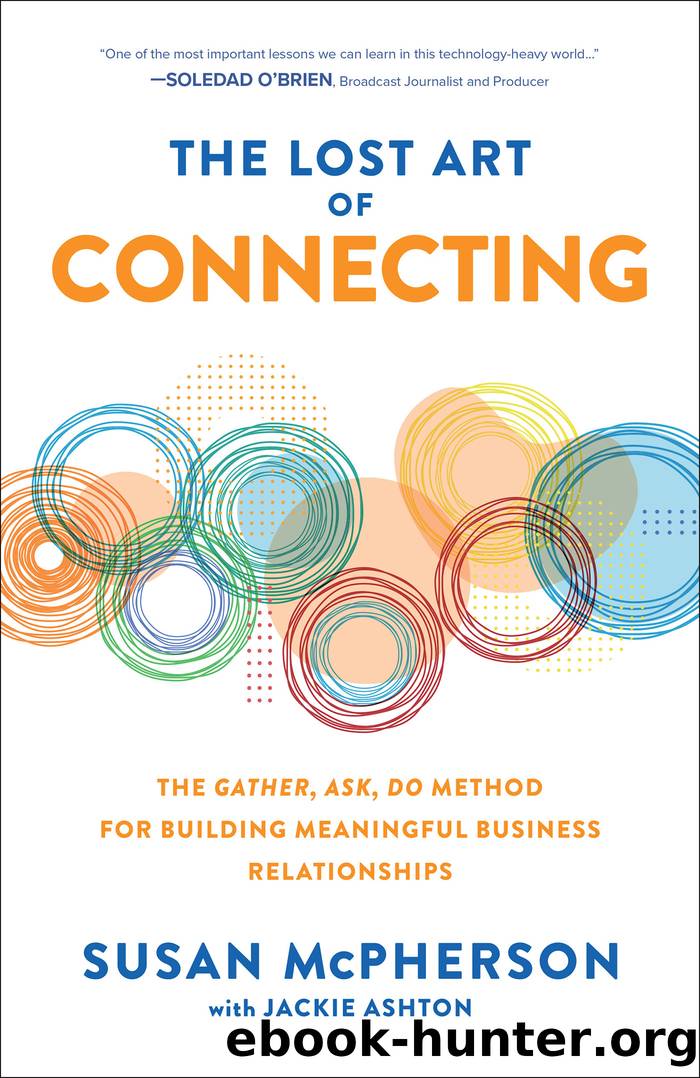The Lost Art of Connecting by Susan McPherson

Author:Susan McPherson
Language: eng
Format: epub
Publisher: McGraw-Hill Education
Published: 2021-06-15T00:00:00+00:00
HELP TO DISSOLVE FEAR OF FAILURE
As human beings we all have insecurities that lead to a fear of being judged. When it comes to connectingâor doing anything, reallyâimagining all the ways that we can fail can cause us to want to quit before weâve even started. And this is another way how the helping mindset takes the edge off. When people act out of fear or feel nervous that other people are judging themâwhen they think, âOh my God, what if it doesnât work?ââthey might freeze or give up and quit, and that prohibits people from taking risks. However, when you become a convener, the risk lessens. When your goal is helping, failure isnât really an option. Even if youâve helped a littleâthat is a win. When Danziger started DailyLit, a digital publisher, the traditional publishers werenât going digital yet. And at the time she was thinking: How do I figure out a way to land my first customer? Instead of giving up, she took initiative and created Publishing Point, where she would convene gatherings once a month, invite a speaker, and open it up to those working in publishing. She launched a Meetup and started securing incredible speakers: company CEOs and professionals from every major trade house, the founder of FourSquare, the founder of Twitter, and others commanding influence. Doing this gave her a seat at the table. Remember what we learned in the Gather section? When youâre the host, you can bring the people you want to your table in a much less threatening way, and it can create tremendous value for all in a way that offers help, kindness, and genuine support.
But waitâcanât being a giver put you in a position to be a doormat? If executed poorly couldnât you possibly get taken advantage of? Where is the line between giving too much versus too little? Adam Grant says that being a giver doesnât mean saying yes to every request. Instead, he proposes, it means setting boundaries around who, when, and how you help. The who is about setting boundaries with takersâif someone has a history or reputation of selfish behavior, youâre not obligated to help. If you give to people who tend to be generous or fair, you avoid rewarding the wrong behavior and invest in spreading norms of generosity. The when is about setting boundaries with time. Failed givers drop everything whenever they get a request; successful givers block out time for their own goals and for self-care. The how is about setting boundaries with the types of help you give. The idea is to be what he calls a âgenerosity specialistâ: help in ways that energize you rather than exhaust you, and in situations where you can add unique value. He also recommends what he calls âthe five-minute favor,â which are high-benefit, low-cost giving favors such as sharing knowledge and making introductions. It makes his day when heâs able to share ideas and evidence in the realm of work and psychology or connect people who benefit from knowing one another.
Download
This site does not store any files on its server. We only index and link to content provided by other sites. Please contact the content providers to delete copyright contents if any and email us, we'll remove relevant links or contents immediately.
The Concise Laws of Human Nature by Robert Greene(1760)
Bioenergetica by Alexander Lowen(1397)
After by Bruce Greyson(1211)
The Child in You by Stefanie Stahl(1171)
No Bad Parts by Richard C. Schwartz(1122)
Stress-Proof Your Brain The Yogic Way: Unique Ancient Indian Techniques to End Toxic Stress, Stop Worrying and Inculcate Mental Toughness by Advait(1075)
Talk of the Ton by unknow(993)
Badass Habits: Cultivate the Awareness, Boundaries, and Daily Upgrades You Need to Make Them Stick by Jen Sincero(993)
The Power of Myth by Joseph Campbell & Bill Moyers(950)
Chakras & Self-Care by Ambi Kavanagh(905)
Self-Care for Empaths by Tanya Carroll Richardson(864)
Learn To Think Using Thought Experiments by King Patrick(848)
The Mind by E. Bruce Goldstein(840)
Curative Magic by Rachel Patterson(821)
The Tao of Intimacy and Ecstasy by Solala Towler(803)
The 7 Secrets of Sound Healing Revised Edition by Jonathan Goldman(802)
The Anxiety First Aid Kit by Rick Hanson(777)
The Quantum Psychiatrist: From Zero to Zen Using Evidence-Based Solutions Beyond Medication and Therapy by Biswas Dona(763)
Living a Life of Awareness by Don Miguel Ruiz Jr(758)
